A two-hybrid antibody micropattern assay reveals specific in cis interactions of MHC I heavy chains at the cell surface
- PMID: 30180933
- PMCID: PMC6125123
- DOI: 10.7554/eLife.34150
A two-hybrid antibody micropattern assay reveals specific in cis interactions of MHC I heavy chains at the cell surface
Abstract
We demonstrate a two-hybrid assay based on antibody micropatterns to study protein-protein interactions at the cell surface of major histocompatibility complex class I (MHC I) proteins. Anti-tag and conformation-specific antibodies are used for individual capture of specific forms of MHC I proteins that allow for location- and conformation-specific analysis by fluorescence microscopy. The assay is used to study the in cis interactions of MHC I proteins at the cell surface under controlled conditions and to define the involved protein conformations. Our results show that homotypic in cis interactions occur exclusively between MHC I free heavy chains, and we identify the dissociation of the light chain from the MHC I protein complex as a condition for MHC I in cis interactions. The functional role of these MHC I protein-protein interactions at the cell surface needs further investigation. We propose future technical developments of our two-hybrid assay for further analysis of MHC I protein-protein interactions.
Keywords: cell biology; endocytosis; immunology; in cis interactions; inflammation; major histocompatibility complex molecules; membrane proteins; protein micropatterns.
© 2018, Dirscherl et al.
Conflict of interest statement
CD, ZH, VR, CJ, SS No competing interests declared
Figures








Similar articles
-
Specific Capture of Peptide-Receptive Major Histocompatibility Complex Class I Molecules by Antibody Micropatterns Allows for a Novel Peptide-Binding Assay in Live Cells.Small. 2017 Apr;13(15). doi: 10.1002/smll.201602974. Epub 2017 Feb 2. Small. 2017. PMID: 28151581
-
Dissociation of β2m from MHC class I triggers formation of noncovalent transient heavy chain dimers.J Cell Sci. 2022 May 1;135(9):jcs259489. doi: 10.1242/jcs.259498. Epub 2022 May 13. J Cell Sci. 2022. PMID: 35393611
-
Peptide variants reveal how antibodies recognize major histocompatibility complex class I.Eur J Immunol. 1993 Nov;23(11):3028-36. doi: 10.1002/eji.1830231145. Eur J Immunol. 1993. PMID: 8223880
-
MHC class I/peptide interactions: binding specificity and kinetics.J Mol Recognit. 1993 Jun;6(2):59-69. doi: 10.1002/jmr.300060204. J Mol Recognit. 1993. PMID: 8305252 Review.
-
Peptides bound to major histocompatibility complex molecules.Peptides. 1998;19(1):179-98. doi: 10.1016/s0196-9781(97)00277-5. Peptides. 1998. PMID: 9437752 Review.
Cited by
-
Homotypic and heterotypic in cis associations of MHC class I molecules at the cell surface.Curr Res Immunol. 2022 May 23;3:85-99. doi: 10.1016/j.crimmu.2022.05.001. eCollection 2022. Curr Res Immunol. 2022. PMID: 35647522 Free PMC article. Review.
-
Open MHC Class I Conformers: A Look through the Looking Glass.Int J Mol Sci. 2021 Sep 8;22(18):9738. doi: 10.3390/ijms22189738. Int J Mol Sci. 2021. PMID: 34575902 Free PMC article. Review.
-
A Simplified and Robust Activation Procedure of Glass Surfaces for Printing Proteins and Subcellular Micropatterning Experiments.Biosensors (Basel). 2022 Feb 25;12(3):140. doi: 10.3390/bios12030140. Biosensors (Basel). 2022. PMID: 35323410 Free PMC article.
-
Soft lithography-based biomolecule patterning techniques and their applications in subcellular protein interaction analysis.Mater Today Bio. 2025 Mar 17;32:101672. doi: 10.1016/j.mtbio.2025.101672. eCollection 2025 Jun. Mater Today Bio. 2025. PMID: 40177382 Free PMC article. Review.
-
Subcellular Dynamic Immunopatterning of Cytosolic Protein Complexes on Microstructured Polymer Substrates.ACS Sens. 2021 Nov 26;6(11):4076-4088. doi: 10.1021/acssensors.1c01574. Epub 2021 Oct 15. ACS Sens. 2021. PMID: 34652152 Free PMC article.
References
-
- Allen RL, O'Callaghan CA, McMichael AJ, Bowness P. Cutting edge: HLA-B27 can form a novel beta 2-microglobulin-free heavy chain homodimer structure. Journal of Immunology. 1999;162:5045–5048. - PubMed
-
- Bodnár A, Bacsó Z, Jenei A, Jovin TM, Edidin M, Damjanovich S, Matkó J. Class I HLA oligomerization at the surface of B cells is controlled by exogenous beta(2)-microglobulin: implications in activation of cytotoxic T lymphocytes. International Immunology. 2003;15:331–339. doi: 10.1093/intimm/dxg042. - DOI - PubMed
Publication types
MeSH terms
Substances
Grants and funding
LinkOut - more resources
Full Text Sources
Other Literature Sources
Research Materials

